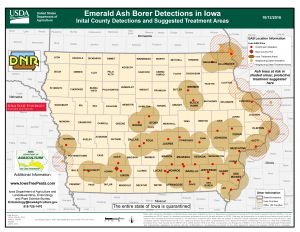Emerald Ash Borer confirmed in Adair & Adams Counties
October 13th, 2016 by Ric Hanson
Authorities in Iowa today (Thursday) say the Emerald ash borer (EAB), an invasive beetle that attacks and kills ash trees, has been confirmed in Adair and Adams Counties. EAB is now present in 28 states after being discovered in Detroit, Michigan in 2002. EAB is native to Asia. Adair and Adams Counties join the growing list of confirmed counties where EAB has been detected in Iowa. Nine counties have been added to the list this year. Iowa first confirmed the presence of this destructive pest in 2010.
The recent discoveries took place at Lake Orient Recreation Area (Adair County Conservation Board) in Adair County and a rural area north of Cromwell in Adams County.
Insect larvae were taken from both sites and later positively identified by federal identifiers as EAB. Mike Kintner, Iowa Department of Agriculture and Land Stewardship EAB and gypsy moth coordinator, says “It is particularly difficult to battle an invasive species like emerald ash borer. One thing people can do to help with this effort is avoid transporting firewood.”
The Iowa EAB Team strongly urges Iowans to use locally sourced firewood, burning it in the same county where it was purchased. Firewood is a vehicle for the movement of EAB. The adult beetle also can fly short distances, approximately 2 to 5 miles.
The adult beetle is metallic green and only about one-half inch long. The larval stage of this wood-boring insect tunnels under the bark of ash trees, disrupting the flow of water and nutrients, ultimately causing the tree to die. EAB-infested ash trees display canopy dieback beginning at the top of the tree and progressing downwards, S-shaped feeding galleries under dead or splitting bark, D-shaped exit holes, water sprouts (along the trunk and main branches), and increased woodpecker activity to the bark.
At this calendar date, the window for all preventive treatments has closed. If a landowner is interested in protecting a valuable and healthy ash tree within 15 miles of a known infestation, he or she should have landscape and tree service companies bid on work, review the bids this fall/winter, and treat beginning spring 2017 (early April to mid-May).
The State of Iowa will continue to track the movement of EAB on a county-by-county basis. Before a county can be officially recognized as infested, EAB must be collected by a member of the Iowa EAB Team and verified by USDA entomologists. To learn more about EAB and other pests that are threatening Iowa’s tree population, please visit www.IowaTreePests.com.






